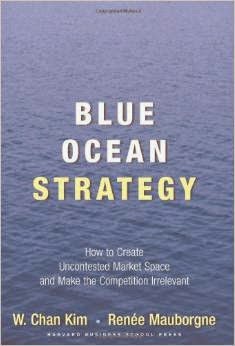What is a blue OCEAN strategy? The authors explain by comparing it to a strategy of the red ocean (traditional strategic thinking):
1. do not compete in the space of the existing market. You must instead create a uncontested market space.
2. not to fight competition. On the contrary, you should make the competition irrelevant.
3. do not operate the existing demand. Instead, you must create and capture a new application.
4 do not value / cost compromise. On the contrary, you must break the value / cost compromise.
5. do not align the whole system of a business with its strategic choice at low cost or differentiation. You must instead align the whole system of the activities of the company in pursuit of differentiation and low cost.
A red ocean strategy is based on the traditional strategic thinking – for example, strategy guru Michael Porter Harvard.
Some cases:
* Airline industry fare wars lead to bankruptcies and low margins. Southwest Airlines creates a new market by offering speed with low-cost air travel and the flexibility of the conduct.
* Industry of the golf equipment in competition to win a greater share of existing customers of golf. Callaway Golf creates a 'Big Bertha', a golf club with a big head which attracted new customers to the golf which had been frustrated by the difficulty of hitting the ball.
* The cosmetic industry creates a red ocean with models, expensive advertising and promises of youth and beauty. The Body Shop creates a blue ocean that lasts more than a decade by the creation of functional cosmetics that have defied the industry who sold emotionally attractive cosmetic products.
* The wine industry glut the market with a Red Sea of thousands of competing brands on the finest oak and tannins and the heritage names vinous. Wines Casella creates [yellow tail], an ocean blue wine that has succeeded in eliminating the complexity, the elitism and the confusion of consumers and create a simple image pleasure that wine drinkers were able to enjoy.
A blue ocean is created in the region where the actions of a company both a favorable effect on its cost structure and the value proposition for buyers. Cost savings are made from to eliminate and reduce the factors of an industry competes on. The buyer value is raised by farming and the creation of elements of the industry has never offered. Over time, costs are reduced by more than economies of scale kick, because sales volumes high that generates a higher value.
Examples of strategic movements which have created blue oceans again, untapped demand:
-NetJets (in the fractional Jet ownership)
-Cirque du Soleil (circus reinvented for the entertainment market)
-Starbucks (coffee luxury low cost for high consumers of range)
-Ebay (online auctions)
-Sony (Walkman - personal portable stereos)
-Cars: cars-saving fuel Japanese (mid-1970s) and Chrysler minibus (1984)
-Computer: Apple Personal Computer (1978) and built to order Dell computers (mid-1990s).
INSEAD professors Kim and Mauborgne wrote regularly on the subject of the value of innovation since 1997 in the Harvard Business Review. Be a Director of the business development, the leaders of their thinking on strategic innovation inspired me tremendously over the years. Their articles were reference texts for many MBA students for a period of time (for example "Value Innovation", "Create new spaces of market", "Charting your company's future"). I think their first book to be as dominant in any library of strategy such as the books of Michael Porter (the guru behind the classic red ocean strategies).










